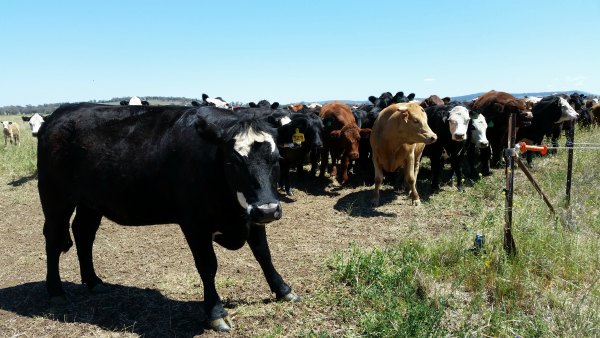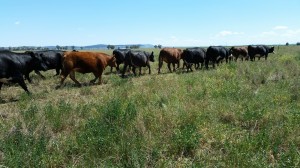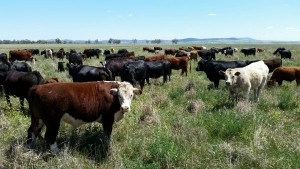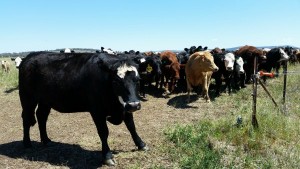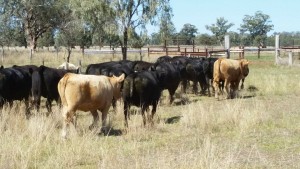We don’t ‘run’ the cattle into the yards anymore! You may recall from a few weeks ago that with low stress stockhandling, attitude is everything. This includes our language. If we don’t want to move our cattle at a constant trot all the way to the yards, then let’s not phrase it this way. I would like to share with you some examples of how Low Stress Stockhandling has helped us in our operations. I think the examples help to give a better understanding of the principles I talked of a fortnight ago.
Whilst we haven’t actively tried to do any comparative measurements with cattle here at home, we have much anecdotal evidence of the benefits. I will share with you some of the differences we have noticed and some specific examples of what we have done.
Bellowing and Nervous Energy
As I have mentioned before, we manage the grazing of our cattle under a planned system. Practicing this way means that cattle are moved more regularly than they would under a set stocking system. Cattle can be moved as often as daily – and even several times a day (depending on paddock size, pasture growth, how much time and how enthusiastic we are feeling about setting up portable fencing and what we want to achieve in that paddock). As a result of these regular moves, cattle had gotten into a habit of expecting to be moved when they heard the bike or ute, regardless of how much feed was left in the paddock. They would be at the gate bellowing, awaiting their next move.
This is a problem, as this bellowing represents a stress in the animal and will affect their performance. They are also not out grazing or sitting ruminating (an important action for performance), whilst they are doing this. We used to go to the gate and let them through – upon which they would most enthusiastically move into the next block, and then continue to do a few laps the length of the paddock, grazing – full of nervous energy. It made for very quick cattle moves, but that was as far as the plusses went! (Also note that cues for moving like whistles or vehicle horns create a similar response in the cattle and lots of nervous energy).
What we were doing by moving the cattle through when they were at the gate was effectively teaching the cattle that they decide when they will move. We needed to take back the control and let them know that ‘we’re not going to move you just because you’re demanding so’. We now realise that knowledgeable observation would have told us that the cattle weren’t settled. So how did we change our cattle’s behaviour?
We now let the cattle know that they will be moved on our terms and our terms only. To do this, we began to move the cattle off the gateway and then move through them in a few figure 8’s or a random pattern and wait for them to settle and move off quietly. This means that the bike is not always associated with a move to a fresh paddock. Once they were settled back into grazing, or just settled, THEN we would gather them up and move them into the next block. Sometimes we move through the cattle even when we are not about to move them into a new paddock. This forms part of the education of the stock.
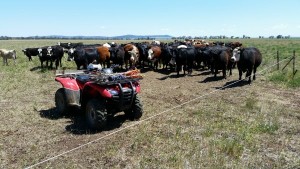
Bringing cattle to the gate on our terms – and holding
Walking to the next paddock
Settled in the paddock
We would also block the cattle as they were at the gate; we would block them at the gateway, let a handful through, then block them again, let another handful through etc. It didn’t take long of these treatments for the waiting at the gate to stop and the bellowing to cease. We now have a very quiet farm.
Blocking at the gate
Settling
The laps up and down the paddock that the cattle would do upon entering a new block (that I mentioned above) meant that the cattle were not settled (which affects performance). Again, observation comes in here; we know cattle are settled when those in the mob are walking off in different directions as they graze. Ensuring that they are settled upon entering a new paddock starts back with how we start to move them in the initial paddock (as mentioned above). We make sure they are settled before beginning the move, and then when they are moved into the new block we now move around in front of them and block them. A good guide to knowing if the mob is settled in the new paddock is making sure that the animals are slowly moving off in different directions as they graze. Sometimes this means getting around in from of the mob and pushing them back on themselves once entered in the new paddock, until they stop moving forward as one group.
animals with a big flight zone
On occasions we have bought trade animals or have taken on agistment cattle that might have a lot of movement in them (or had a big flight zone). The handling of these animals may have in the past caused much trouble and upset, but we are now no longer concerned by this. We know that with a little bit of educating that these animals will become easier to manage and will assimilate into the mob. Something to look for with new animals that have been introduced to a mob is seeing if they are still ‘hanging out’ together within the larger mob. If you see a new group of cattle still sticking together within a larger mob, this is an indication that they haven’t assimilated well.
Induction
We try to start the education process as soon as they set foot on the place – and this is relevant to educating weaners too. As we let them out of the yards, we move out the gate in front of them, then as they move out we block them (to a stop) and move them back into the yard, then let them a little further out, block them etc. We will move them back into the yard again and go through this process a few times. Working with the animals in this way, as well as out in the paddock, is helping to educating them to block, move off pressure and to hold (which I talked about in my blog two weeks ago).
We also educate them to electric fences at induction, by having them in an outside yard with an electric fence.
Recently we had some cattle come in that we didn’t have time when they came off the truck to go through this induction process straight away. We put them in an outer yard until the next morning, when we intended to ‘induct’ them. Upon going to the yard in the morning – no cattle!! They were not flighty animals, but they were found four paddocks away on a neighbour’s farm, ready to be inducted and educated.
No Bruises
This year we have begun direct marketing our beef and I recall someone commenting about ‘how would we manage the bruising?’ We have not had one single bruising issue for this whole year.
Feedlot experience
A few years ago we sent a group of our yearlings to a feedlot. The steers and heifers had been running together as a group with us, so the feedlot decided to leave them together (not usually done) and the feedlot pen was filled with just our cattle. The feedback we received from the feedlot was that the animals performed really well, with ZERO health costs at all (just about unheard of in that industry), apart from standard induction. How much of this was attributed to low stress stockhandling and how much was attributed to other factors like their nutritional/health status entering the feedlot, we don’t know.
Other experiences with low stress stockhandling in feedlot situations are similar however. Jim Lindsay of Low Stress Stockhandling told me of one 14,000head feedlot, which implemented changes in several different areas, one of them being using some LSS methods. One of the outcomes was the lowering of the medical bill from approx. $10,000 per month to around $2,000. This increased profit by more than $90,000 per year. This is without considering the increased production because the animals are in a healthier state of mind.
So you can see that by being conscious of our actions and just changing our practices a little, we can have a significant impact on our daily activities and the productivity and profitability of our operations. The examples of lowering animal stress for better production (and health) also make me think, why would it be any different for us? Remember the LSS motto – attitude is everything. If our attitude determines our outcomes with our livestock –Why is it any different to other areas of our lives?

